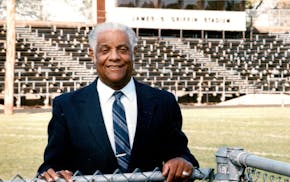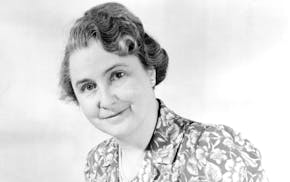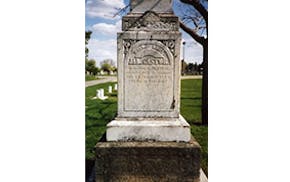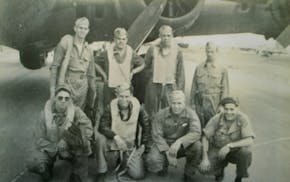During a one-point victory over Little Falls at the 1918 Minnesota boys' high school basketball tournament, Duluth Central High center Eugene Watts Jr. twisted his ankle — limping off the floor and into the nearly forgotten ranks of historical footnotes.
The son of a Mississippi-born janitor, Watts — nicknamed "Boots" — is believed to be the first Black player in the history of the tournament, which turns 109 next week. Watts' appearance in the sixth tournament in Northfield came two years before three African American circus workers were lynched in his hometown of Duluth when a woman falsely accused them of rape.
"Boots had little trouble in out-jumping all opposing centers," according to the 1918 Zenith, the yearbook for Duluth Central, which closed in 2011. "He played a hard consistent game all season … Watts covered his position in a splendid manner."
The Zenith said Watts was the "deciding factor" in Central's victory over Buhl in a district title game in Eveleth in 1918. After twisting his ankle in his first state tournament game, Watts missed Central's next game, a 32-31 squeaker over pre-tournament favorite St. Paul Humboldt. He also missed his team's 24-18 loss to Waseca in the championship.
"It was due in large part to his injury that we lost the state championship," the yearbook said.
For years, tournament historians considered two African American members of the 1947 St. Paul Marshall team — Leon Combs and Curtis Russell — the racial barrier breakers. Hopkins' Bob Wagner made the all-tournament team in 1951 and 1952, and St. Paul Central's LeRoy Gardner and Jim Hill joined those pioneers in the mid-1960s.
But Watts beat them all by a generation. Northfield hosted the first decade of state hoops tournaments at Carleton College before the event moved to the Twin Cities, where it's been held in a variety of venues. Those early years in Northfield attracted scant newspaper coverage.
"Rarely have news reports ever made things easy for those in the distant future by simply saying that a player, any player, was African-American," Minnesota basketball historian Marc Hugunin wrote in 2018 on his Minnesota Hoops blog.
Hugunin co-authored a 2006 book, "Minnesota Hoops: Basketball in the North Star State," that said Wagner was the state tournament's first Black player in 1951. He later noted in a 2012 state tournament program article that Combs and Russell actually had appeared in 1947.
But four years ago Duluth Central hoops historian Larry Lodmell tipped off Hugunin about Watts, who played in the state tournament 29 years before Combs and Russell.
"In the case of 'Boots' Watts, well, thank goodness there's a photo," Hugunin wrote. "It shows a strapping young African-American man — long and lean, but muscled — whose proportions suggest a fellow of about 6-3."
That photo, showing Watts wearing kneepads, high socks and a big "D" on his jersey, pops up on Ancestry.com, along with his World War I draft registration with boxes checked for "Tall" and "Slender."
No such questions surround the state girls' high school basketball tournament, which gets underway this week. The first official girls' tournament didn't happen until 1976, when St. Paul Central High School won with a team featuring African American players Lisa Lissimore, Linda Roberts and Rita Burch.
"Boots" Watts was born April 25, 1900, in Duluth, the third child of Eugene and Emma Watts. By 1925, he appears as a basketball and football player in the yearbook of the La Crosse Normal School, now known as the University of Wisconsin-La Crosse.
In 1926, Watts married Alma Keeling, a Louisiana native who had attended Duluth's Denfeld High School. Their son, Eugene Benjamin Watts III, was born in Duluth the following year.
By 1930, according to the census, the family had moved to Chicago, where Watts worked at an auto garage. Two years later the family was living in the Chicago suburb of Evanston, and Watts was working as a painter, when he died at 32.
Alma and their son returned to Duluth, according to a 1936 city directory. They had moved to Philadelphia by the time Eugene III registered for the draft in 1945. He died in 2002 at 74.
The story of basketball pioneer "Boots" Watts is sadly filled with questions. Where did he get his nickname? Why did he die so young? Did son Eugene III have any kids, leaving living descendants? I was unable to find any of these answers.
But the 1940 census shows his son living in Duluth with his grandparents at 915 E. 6th St., the same house that "Boots" had listed on his World War I draft card 22 years earlier. He had filled out that card six months after twisting his ankle in the state basketball tournament — taking him out of the competition, but having already secured his place in tournament history.
Staff writer Joel Rippel contributed to this report.
Curt Brown's tales about Minnesota's history appear each Sunday. Readers can send him ideas and suggestions at mnhistory@startribune.com. His latest book looks at 1918 Minnesota, when flu, war and fires converged: strib.mn/MN1918.

Minnesota History: Ad man turned Paul Bunyan into a folklore icon

Minnesota History: James Griffin used persistence to blaze a trail for St. Paul's Black police officers

Minnesota History: For Granite Falls doctor who tested thousands of kids for TB, new recognition is long overdue

Minnesota History: A New Ulm baker wearing a blanket fell to friendly fire in the U.S.-Dakota War


